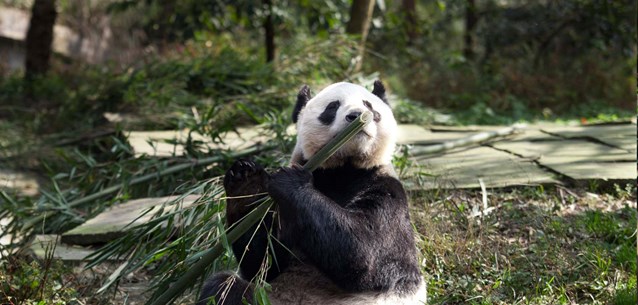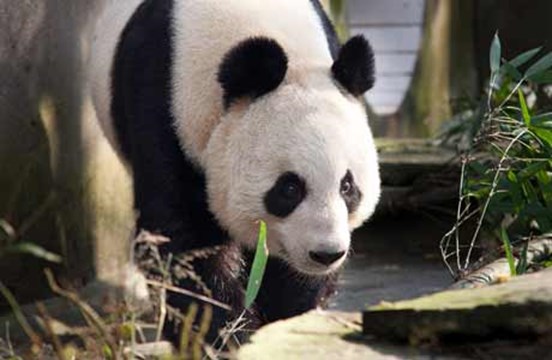Giant panda reintroductions to the wild
24/04/2016 in Conservation
In the last few years, Chinese experts have restarted work to reintroduce pandas to the wild.
Originally commencing in 2007, we know that some of the animals that were reintroduced as part of the original programme died as they were fitted with radio collar trackers. It actually may very well be that many young animals, at the point of dispersal in the wild, die anyway from defending themselves, establishing territories or even falling out of a tree - which does actually happen to wild pandas.

There has been a huge amount learnt over this time period with the knowledge gained from that project; techniques and ideas were further developed that paved the way for a programme of reintroductions to commence again in 2012, with two to three pandas reintroduced to the wild each year. RZSS believes this is absolutely the right and sensible approach as giant pandas are complex mammals who live solitary lives.
In addition to the huge amount of scientific knowledge that now exists, accumulated over the years, there are three important elements for success that are very similar in all reintroduction programmes and all the elements are very much in place right now as we go forward. The Chinese want to do it right and to continue to learn, develop and perfect the reintroduction programme.
Firstly, we as a collective have a good sound genetic base within the captive population of pandas.
Secondly, before reintroductions take place, a huge amount of pre-release training must happen, which takes around a year and a half per young panda. Animals are put into huge – and I mean absolutely huge – enclosures, which are in very remote areas in Wolong and the animals are left alone, but still heavily monitored from a scientific perspective. These animals get used to the things they would meet and deal with in the wild and by the time they are ready they have the life skills that they need to survive in the wild. The name of the game now, is essentially quality not quantity and that we have animals that are psychologically and behaviourally appropriate for a life in the wild.

Finally, at the same time you have to have the habitat in order for these animals to go into. Animals are now being put into ‘corridors’ that link pandas from one reserve to the other and this is only possible because of a reforestation and restoration program that was put in place quite some time ago.
Things are coming together – we have sufficient animals in captivity and a variety of genetics, the perfecting of pre-release training is happening and corridor reserves have and are being established.We should be celebrating that we have 422 pandas in captivity and it is best to think about the captive and the wild populations being managed as one and understand that there will be flow between the two. Yes there will be lessons learned, as there are always lessons learned in captivity, however we really should hold this up as model programme and celebrate it.
In ten years’ time it is hoped that we will have fewer, but bigger, panda reserves with sufficient forest and habitat between them to allow free movement of pandas through their current range, thereby ensuring the wild panda population is genetically stable and sustainable. The goal is also to raise and stabilise the captive population at around 500 individuals, with the emphasis being on producing and maintaining a physically and mentally, healthy population which can help and support the conservation of the wild population through further reintroductions and research.
 Iain Valentine
Iain Valentine
Director of Giant Pandas at the Royal Zoological Society of Scotland
Featured Articles

An update from the Budongo Forest
19/04/2024 in Conservation

Edinburgh Zoo named best zoo in Scotland
15/04/2024 in Edinburgh Zoo
Latest News
-
News

04/12/2023
Edinburgh Zoo’s giant pandas leave zoo and board flight to China
Edinburgh Zoo’s giant pandas, Yang Guang and Tian Tian, left the capital this morning (Monday 4 December) and were safely boarded on a flight to China after twelve years in Scotland.
-
News

17/11/2023
Final chance to see Edinburgh Zoo’s giant pandas
Panda enthusiasts have just two more weeks to say goodbye to Britain’s only giant pandas.
-
News

04/09/2023
Edinburgh Zoo’s giant pandas to return home in early December
The Royal Zoological Society of Scotland (RZSS) has announced that giant pandas Yang Guang and Tian Tian will return to China in early December 2023.
-
News

15/08/2023
Edinburgh children celebrate giant panda’s final birthday in UK
The Royal Zoological Society of Scotland (RZSS) celebrated the 20th birthday of its male giant panda Yang Guang yesterday at Edinburgh Zoo.

























Follow EZ